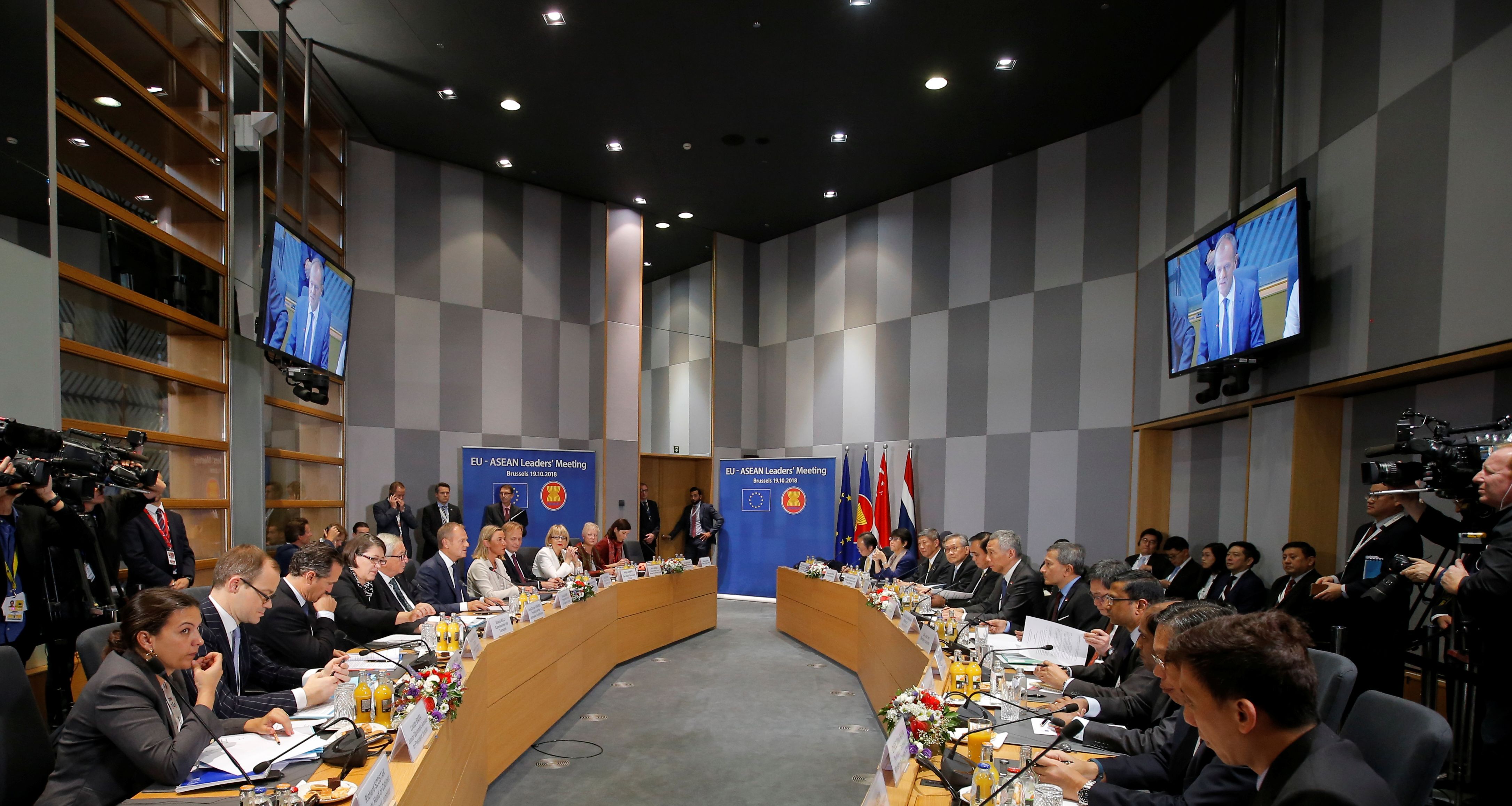ASEM at 25: Challenges and Opportunities for the Asia-Europe Dialogue

On 1-2 March 1996, the first Asia-Europe Meeting (ASEM) summit was held in Bangkok, attended by representatives of the 15 EU Member States and the European Commission, and 10 countries from Asia—the seven ASEAN members at that time along with China, Japan, and South Korea. Now, 25 years later, the dialogue has 53 members—the 27 EU countries, Norway, Switzerland, the UK, and 21 countries from Asia, as well as the EU and ASEAN secretariat. ASEM members account for 60% of the world’s population, 62% of global GDP, and 55% of trade. In the absence of a pan-Asian regional organisation similar to the African Union, for example, ASEM has been the largest forum for contact between partners from the EU and Asia. An important event in this anniversary year will be the 13th ASEM Summit in Cambodia in June 2021, postponed from November last year due to the COVID-19 pandemic.
The ASEM Way
An informal platform for dialogue and interregional cooperation, ASEM has no permanent secretariat and no budget. The cooperation covers three main pillars: political, economic and financial, and socio-cultural and educational. Leaders summits are held every two years (the last one took place in 2018 in Brussels) and there are more frequent meetings of ministers in various fields (e.g., foreign affairs, economy, transport, culture, science), Senior Official Meetings, forums for parliamentarians, and meetings between representatives of business, science, think tanks, journalists, artists and students. The main institution within ASEM is the Asia-Europe Foundation, which supports dialogue between societies. In 2009, a Secretariat for Education was launched to promote cooperation in this field. In recent years, the priority of cooperation has been multidimensional connectivity between continents and sustainable development.
ASEM has been criticised as an insignificant talking shop and photo-op forum that does not bring concrete results or solutions to current problems. The dialogue is not widely known even in the societies of the Member States. Its minor importance for many members is demonstrated by their sending low-ranking representatives to the meetings. Basing ASEM’s work on consensus also leads to the avoidance of sensitive topics and general statements during and after summits. There is also untapped potential to voice a shared position of the 53 members in international organisations. The further expansion of ASEM is hampered by the need for unanimous consent of the current members.
Challenges and Opportunities
ASEM faces a test driven both by internal constraints and international challenges. In addition to fighting the pandemic, rebuilding economies, and eradicating poverty, ASEM is faced with new regional problems. Tensions between China and other Asian (e.g., India, Australia) and European countries may make it even more difficult to find consensus on key issues. The U.S.-China rivalry further strengthens regional divisions despite the fact that most ASEM countries reject unequivocally taking sides in this competition.
Normative issues and the observance of human rights in Asia are becoming a more serious problem. For this reason, in July 2020, the EU partially suspended trade preferences under the “Everything But Arms” regime for the host of the ASEM Summit—Cambodia. With the next meeting to be held there, that may hinder the discussion on human rights, lower the political representation of some members, and increase criticism of the forum. The situation was additionally complicated by the coup d'état in Myanmar on 1 February this year, which has been strongly condemned in Europe but more divisive in Asia.
Despite the problems, the economic and political ties between the EU and Asia are tightening. Asian ASEM members account for more than a third of the EU’s trade, and China itself, albeit mainly as a result of the pandemic, replaced the U.S. in 2020 as the Union’s largest partner in trade in goods. The EU’s economic ties with Asia may be strengthened by the investment agreement with China, the negotiations of which ended in December 2020, or the planned free trade agreements with Australia and New Zealand. Moreover, in December, the EU and ASEAN raised the profile of their relationship to a “strategic partnership”. The cooperation with India has also gained dynamism, as reflected in the special informal summit planned for May this year with the leaders of all 27 EU members in Porto, Portugal.
The EU is also showing increasing interest in the Indo-Pacific concept being developed in the region. The Union is preparing its own strategy after France, Germany, and the Netherlands adopted strategies on the subject. ASEM includes the most important countries supporting the Indo-Pacific concept (except the U.S.), as well as its biggest critics, China and Russia. The inclusiveness of this format and the broad representation of different perspectives makes ASEM a convenient place to discuss concerns about this concept and reduce partner distrust. The possibility of leaders of rival states meeting in an informal setting and continuing the dialogue despite their differences makes ASEM a particularly useful forum at present.
Prospects and Recommendations
Tensions between the EU and some ASEM members (China, Russia, Myanmar) create problems for the smooth functioning of the forum and may contribute to the failure of the Cambodian summit. A test for this forum may be how to put pressure on the military junta in Myanmar in order to return the country to the path of democratisation. The failure to come with a strong joint summit statement would weaken ASEM and favour the forum’s marginalisation. While it would most likely continue to exist as a useful forum for enhancing people-to-people contacts, it would have little political relevance.
However, the growing importance of the relationship between Europe and Asia means that it is in the interest of all ASEM members to strengthen the forum and make it a key mechanism for cooperation between the continents. While the informal nature of the dialogue is considered satisfactory by many and there is no will to institutionalise it, there is room for action that will strengthen ASEM’s international role.
Among the opportunities, first, enhanced cooperation on the most important trans-regional issues would demonstrate the utility of this mechanism to the various publics. The most important challenges requiring cooperation include the “3Cs”: COVID-19 and its socio-economic consequences; Connectivity (expanding the network of interregional connections); and Climate change (to strengthen resilience). To prevent ASEM from being limited to information exchange and meetings, members may consider pooling resources to create a special Trust Fund to finance trans-regional projects addressing the “3Cs”.
Second, expanding membership to other countries in Europe and Asia would create a representative forum for cooperation similar to what the EU has with Africa or Latin America. The issues of interregional connectivity, threats to security, and migration require the cooperation and participation of all states on both continents. ASEM members may therefore consider accepting new members from the Balkans, Eastern Europe, or the Middle East.
Third, ASEM should be actively involved in the pivotal discussion of the Indo-Pacific vision today. The EU’s approach appears close to that of most Asian partners, which see the region as open, inclusive, based on international law and with ASEAN in a central role. It is in the interest of ASEM members to promote the Indo-Pacific as a region of multilateral cooperation rather than competition, including setting standards in new areas (e.g., digitalisation) and supporting sustainable development.
Strengthening ASEM is in the interest of Poland as it allows for regular meetings at the highest level and strengthening political and economic relations with Asian partners. Poland is particularly interested in opening a forum for Ukraine and the Balkan states and developing transport connections to capitalise on its strategic location. It may also submit its candidacy as the new host of the Secretariat for Education, which would enable closer cooperation with Asian countries in a strategically important field.


